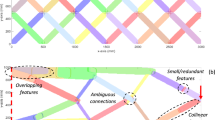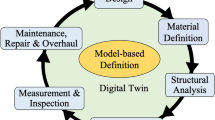Abstract
The concept of feature was introduced because of need to integrate the design and the manufacturing activities. Therefore, the generation of features usually occurs after design completion. However, in recent product development approaches such as concurrent engineering (CE), features need to be generated during design evolution. This paper presents an incremental feature generation (IFG) and feature modification (FM) approach applicable during design evolution, defined by constructive solid geometry (CSG) and boundary representation (B-rep). In IFG, a classified boundary component, obtained from boundary evaluation, is defined as a protrusion or depression (P/D) according to Boolean operation and convexity analysis. The existing features are then updated in accordance with feature interactions in the FM. The FM involves feature existence analysis and modification procedures. The modification procedures are; 1) decide whether the remaining part of an existing feature is valid for a feature definition, 2) update it as a new feature and 3) define the feature relationship. In the IFG approach, the geometry of the current design step is automatically isolated by Boolean operation and defined as a protrusion or depression (P/D) without convexity calculation of topological entities such as edges or face sets. The above procedures are performed through tracing Boolean operations and convexity checking of an intersection edge loop generated during design evolution.
Similar content being viewed by others
References
Chang, T. C., 1982, “TIPPS-Totally Integrated Process Planning System,” Ph.D. Thesis, Virginia Polytechnic Institute.
Chen, B., 1982, “ROMAT — A New Link Between CAD and CAM,”CAD, Vol. 14, No. 4, pp. 261–266.
Chen, Y. M., Miller, R. A. and Lu, S.-C., 1982, “Spatial Reasoning on Form Feature Interactions for Manufacturability Assessment,”Proceedings of the 1992 ASME International Computers in Engineering, Vol. 1, pp. 29–36.
Chiyokura, H., 1988, “Solod Modeling with DESIGNBASE, Theory and Implementation,” Addison-Wesley Publishing Company.
Choi, B. K., 1982, “CAD/CAM Compatible Tool Oriented Process Planning for Machining Centers,” Ph.D. Thesis, Purdue University.
Cutkosky, M. R., Tenebaum, J. M. and Muller, D., 1988, “Features in Process-Based Design,”Proceedings of the ASME Conference on Computers in Engineering, No. 6.
Dixon, J. R., Libardi, E. C., Luby, S. C., Vaghul, M. V., 1985, “Expert Systems for Mechanical Design: Examples of Symbolic Representations of Design Geometries,”Applications of KBS to Engineering Analysis and Design. ASME Winter Annual Meeting, Miami, FL.,
Floriani, L. De and Bruzzone, E., 1989, “Building a Feature-based Object Description from a Boundary Model,”CAD, Vol. 21, No. 10, pp. 602–609.
Henderson, M. R., 1984, “Extraction of Features Information from Three Dimensional CAD Data,” Ph.D. Thesis, Purdue University, West Lafayette, IN.
Hummel, K. E., Brooks, S. L., 1986, “Symbolic Representation of Manufacturing Features for an Automated Process Planning System,”Proceedings of Winter Annual Meeting of the ASME, Anaheim, CA., pp. 233–243.
Joshi, S. and Chang, T. C., 1988, “Graph-based Heuristics for Recognition of Machined Features from a 3D Solid Model,”CAD, Vol. 20, No. 2.
Kyprianou, L. K., 1980, “Shape Classification in Computer Aided Design,” Ph.D. Thesis, Cambridge University.
Laakko, T. and Mantyla, M., 1993, “Feature Modeling by Incremental Feature Recognition,”CAD, Vol. 25, No. 8, pp. 479–492.
Mantyla, M., 1988, An Introduction to Solid Modeling, Computer Science Press.
Mortenson, M. E., 1985, Geometric Modeling, John Wiley & Son, Inc.
Ostrowski, M. C., 1987, “Feature-based Design using Constructive Solid Geometry,”General Electric Corporate Research and Development, Internal Paper.
Rossignac, J. R., Borrel, P. and Nackman, L. R., 1988, “Interactive Design with Sequences of Parameterized Transformations,”IBM Research Report RC 13740. IBM Research Division, T. J. Watson Research Center, Yorktown Heights, NY, 10598.
Shah, J. J., 1991, “Assessment of Features Technology,”CAD, Vol. 23, No. 5, pp. 331–343.
Suh, H., Ahluwalia, R. S. and Miller, J. E., 1991, “Feature Generation in Concurrent Engineering Environment,”Proceedings of Symposium on Solid Modeling Foundations and CAD/CAM Applications, Austin, Texas. June 5–7, pp. 493–502.
Vandenbrande, J. H. and Requicha, A. A. G., 1990, “Spatial Reasoning for Automatic Recognition of Interacting form Features,”Proceedings of the 1990 ASME International Computers in Engineering.
Author information
Authors and Affiliations
Rights and permissions
About this article
Cite this article
Suh, H. Incremental feature generation and modification during design evolution. KSME Journal 8, 422–435 (1994). https://doi.org/10.1007/BF02944714
Received:
Issue Date:
DOI: https://doi.org/10.1007/BF02944714




